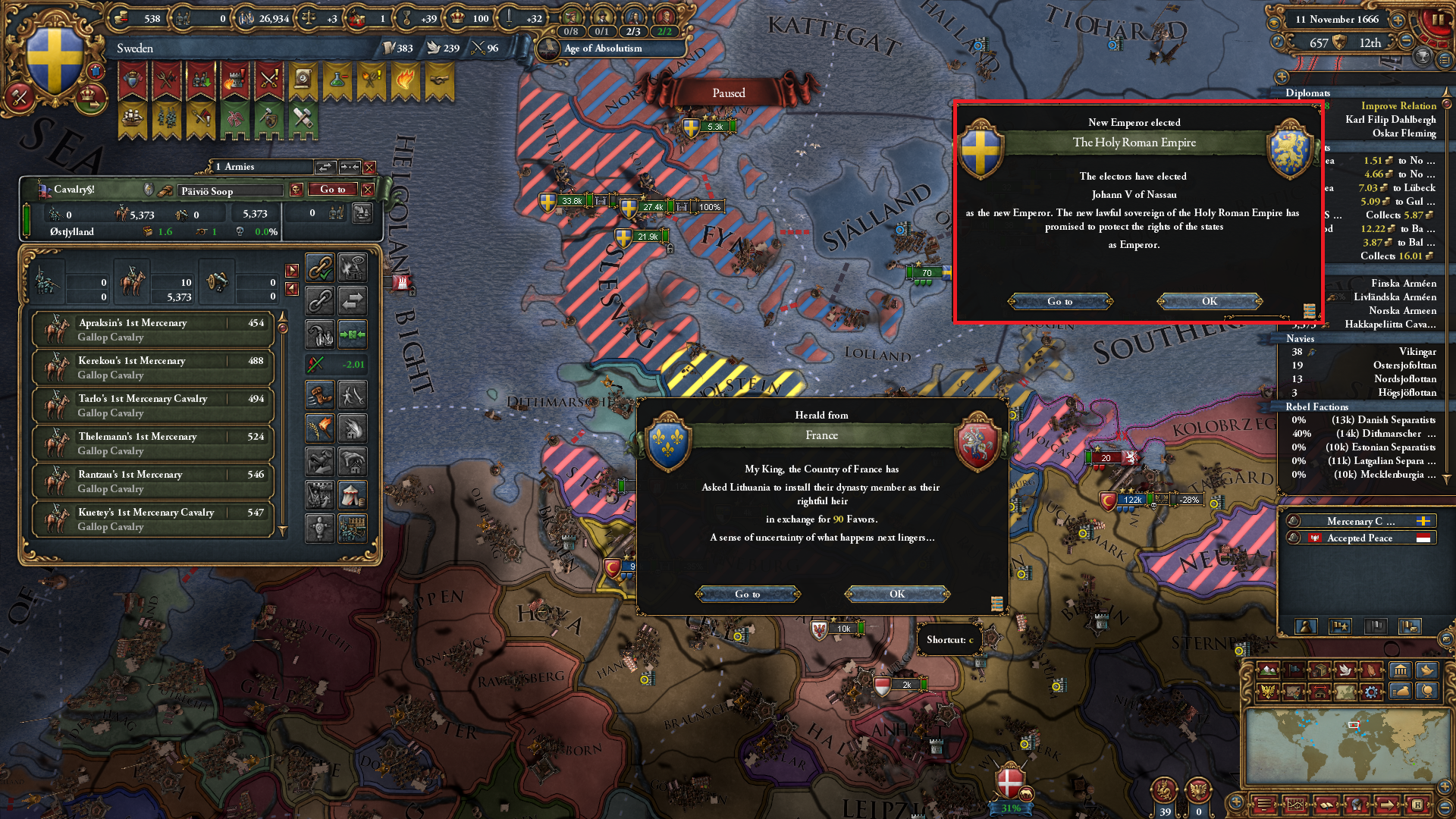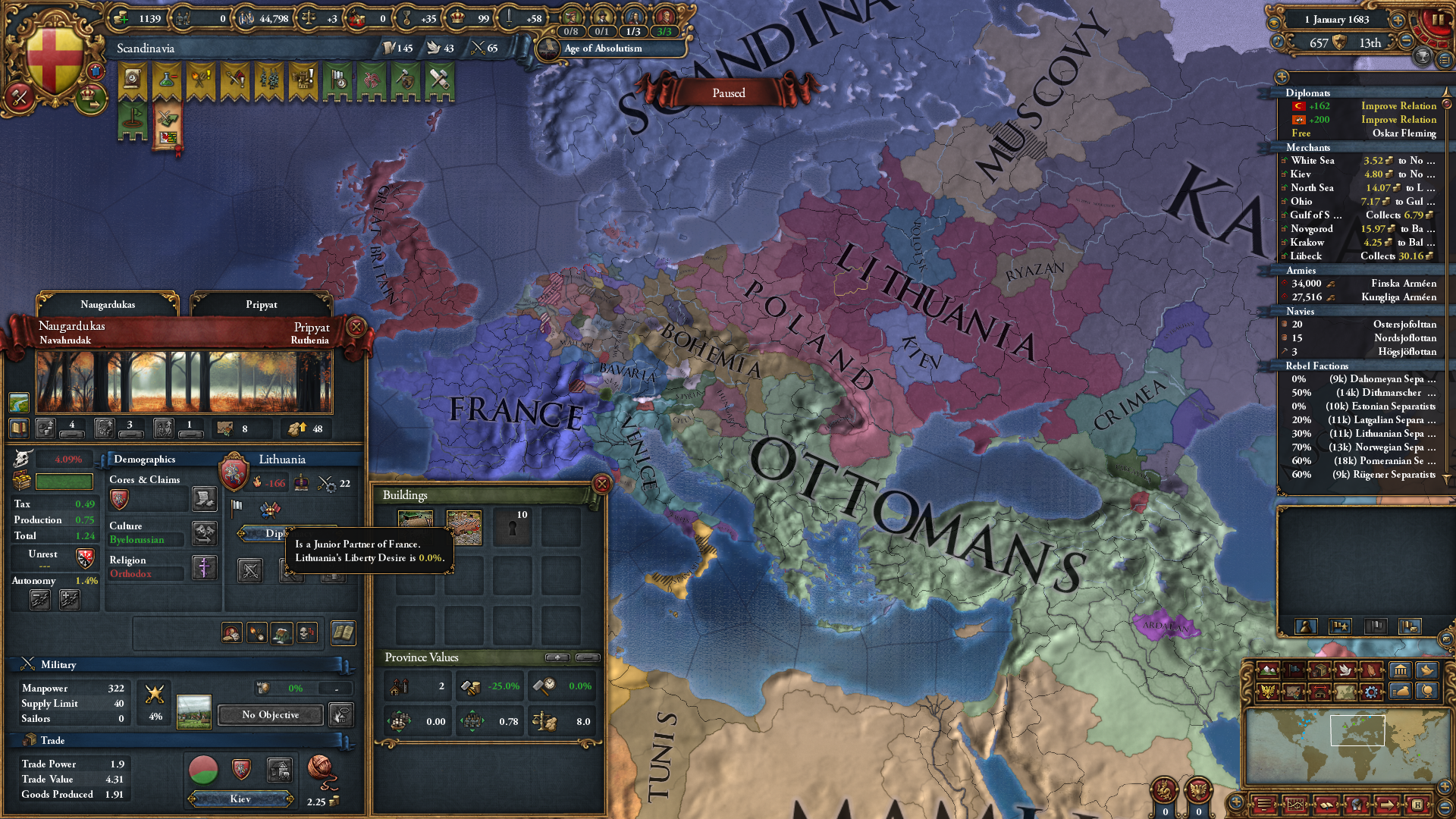Chapter 33- The Wars of Lithuanian Sucession
The latest escalation was set off by the death of the childless Grand Duke Zygimantas of Lithuania. Per his will, his heir was his cousin, King Louis XVII of France. However, the memories of King-Emperor Henri and his ambitions of European hegemony were fresh in everyone’s mind, so Poland, with the backing of Spain and Venice, claimed that, as Poland and Lithuania had once been united, in the absence of a clear succession, the Grand Duchy should be incorporated into the Polish Commonwealth.
Fig. 1- Alliances in the War of Lithuanian Succession
The Norse could not afford to sit aside in this conflict. They agreed to a peace with Kazan, taking the former Novgoridian lands, but little else, and readied the armies. But which side to intervene on?
Fig. 2- Territorial changes in the treaty of Kargopol
Perhaps surprisingly, it was the involvement of Venice that was the deciding factor. There was a risk that the Spanish army (largely believed to be the greatest in Europe at the time) could, in a sufficiently desperate situation, bypass France entirely and fight in Eastern Europe first. Besides, while France was fearsome by itself, Poland’s clout was in a large part due to its alliance with Spain- if that should ever fail, Poland-Lithuania would be more manageable than France-Lithuania. There was some delay before the war started, as the Ottoman Empire had had an agreement with Lithuania to allow passage during the war with Kazan, and the famously-principled Turkish Padishah Mehmed IV insisted on formally voiding that agreement rather than “abusing” the terms to gain an advantage over Lithuania. This being a largely-unplanned-for opportunity on the Swedish meant that the preparations were generally a bit choppy, with many units being deployed after the bare minimum of firing drill.

Fig. 3- Letter from Mehmed IV to Karl the Wolf, dated 1677 “Please give some warning of such adventures in the future, so that I may avoid the appearance of duplicity”
A decree was published that if the Lithuanisn Grand Duchy was defunct, then the Varangian lands it had controlled were rightly a part of the Thanedom of Varangia, and that the Kingdom of Sweden would send forth her armies to ensure that the loyal vassal Yuriy would get what was his. The hope was that the armies of France would be too buy in the west to interfere. Initially, it seemed to be going well- the old Ruthenian fortresses of Rzhev and Pskov were besieged, and the former Ducal Lithuanian Army, without a consensus whether to obey the orders coming from Paris or Warsaw, failed to relieve Pskov either in a timely manner or with sufficient force.
Fig. 4- Map of the First Battle of Pskov
However, the defeat gave the Lithuanians more cohesion, not less, as the commander of the Lithuanian forces there, Count Svitrigaila Oginskis, was the leader of the pro-Polish faction. His personal defeat, and the entry of third party, gave weight to the words of his rival, the pro-French Count Henrikas Visnioviekis, who held that Lithuania would do better with a powerful partner if Scandinavia had designs on her northern and eastern lands. The Norse armies, believing that victory was at hand, pushed on to Riga, only to be shocked to hear that the besieging forces at Rzhev had been driven off by a Lithuanian counteroffensive. The only reason any had survived was that the Hakkapeliitta had fought a valiant rear-guard action, at the cost of every one of their lives. It is said that on that day, all business in Valhalla was carried out in the Finnish language.
Fig. 5- Finnish devotional art of Hakkapeliitta riding across the bifrost
The Norns seemed fickle, though, for the fates of war changed yet again, though the war had not yet been going for a year. The people of Riga did not know of the events at Rzhev (for they were surrounded on all sides save the sea, and Rzhev was far inland in the opposite direction), and they also believed that the Scandinavians were absolutely winning. Thus, the mayor of the city negotiated a surrender, for the French navy could promise them no relief any time soon (they did not even know exactly what Visnioviekis was doing). Additionally, the Lithuanian unity seemed ephemeral, with victory emboldening Oginskis to act independently of his rival once again. Thus, Visnioviekis’ levies alone marched to retake Pskov, and were vanquished there. The Duke of Bavaria dared even proclaim his support for his Norse allies.
Fig. 6- Troop movement, spring of 1679
The effect of this, however, was to persuade King Louis that the Lithuanians were utterly unreliable, and that the Norsemen must be dealt with himself. The Norse hopes that he would be occupied fighting the Spanish had proved unfounded, for the latter had little interest in moving the Pyrenees Front, preferring to move into disputed Lithuania itself, leading to at least one confirmed awkward instance of the Norse and Catholic armies fighting side-by side. This, the French prosecuted with ruthless efficacy, and by the year’s end, all of Norse Denmark and Mecklemburg were occupied, the main fleet had been thrust aside, and the French army was attempting a landing in Scania.
Fig. 7- French troops burning the Sacred Grove of Lubeck, line-drawing by an artistically-minded French army chaplain.
The Norse army under the experienced Axel Jagerhorn redeployed back from the front to defend the home countries. The fighting was fierce, and though the first wave was seen off, a second and larger wave of French troops took the opportunity to cross the Sound and form up as the fighting was ongoing, and attacked while the Norsemen were still weary. Desperate for an advantage, Karl the Wolf begged Duke Ferdinand Maria of Bavaria to open up another front. He acceded, but said that he did not know how long Bavaria could stand alone.
Fig. 8- French troops crossing the Sound, from a Lithuanian animated history documentary.
Buoyed by their victory, the French pursued the Norsemen into Sweden. However, the former became strung out, so when the latter relied at a great temple of Odin, they were able to turn around and route them. In addition, by this time the Turkish army had arrived in Mecklemburg. Once again, Scandinavia prepared for rebuilding after the war.
Fig. 9- Troop movements in Denmark-Mecklemburg, summer of 1681
In Insular Denmark, however, it was the French’s turn to rally, meeting up with a force of German mercenaries under the famous Siegfried Buschmann, alongside whom they defeated the vanguard of the Swedish army and prematurely declared victory and celebrated before being themselves driven from the island by Axel Jagerhorn’s main force. Though Jagerhorn boasted of his victory, and Tyrol conceded, the situation was in fact dire. Sweden had taken heavy casualties, the Spanish, on whom Karl the Wolf had depended on to distract the main French army, were underperforming, and Bavaria was on its last legs.
Fig. 10- occupation of Bavaria, 1681.
What was more, the Ottoman were proving somewhat unreliable as well. Well the Turks were serving well as occupation forces in Lithuania and Mecklemburg, they seemed reluctant to commit to a full invasion of France, and it was increasingly clear that this was what it would take to extract major concessions. As such, in 1682, Scandinavia and France agreed to a peace treaty acknowledging Louis as the rightful ruler of Lithuania, but this would not include the lands around Rzhev and Ryga. Though these were fairly minor territorial concessions, they were not the pittance Louis, perhaps, believed- Ryga was a major Baltic trade city, and Sweden had had designs on it since breaking from the Danish yoke all those years ago.
Fig. 11- Territorial changed in the Treaty of Calais
With Scandinavia out of the war, Poland conceded later that same year, and the Ruthenian Legacy was finally secured not by any of the initial disputants but by distant France- who, some noted, had just fought most of the other European powers at once and more-or-less prevailed.
Fig. 12- official painting of the coronation of King Louis/Liudvikas in Vilnus































































